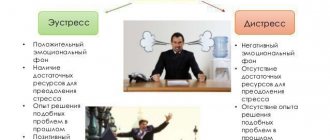Modern psychological science is based on such basic concepts as “personality”, “consciousness”, “activity”, “communication”. Often the concept of activity in psychology is interpreted as a unique form of the subject’s relationship to the world around him. Moreover, this attitude is conscious, aimed at its development and transformation to the extent that it seems appropriate to the individual. The role of consciousness depends on the type of activity - in scientific, work or play, its psychological component is different.
Activity is recognized as the basis for personality formation.
Articles on the topic
- What is professional stress, its main signs and types 08/29/2021
- Self-analysis and self-assessment of a teacher’s professional activity as the main criteria for his work 08/13/2021
- What is the role of self-esteem in choosing a profession 08/13/2021
- What does success in business depend on and how not to lose it 07/12/2021
A purposeful attitude towards the world is realized in the following types: cognitive, evaluative, spiritual or material, reproductive, creative and many others.
Psychological characteristics of activity
The activity has the following features unique to it:
- Subject : each activity has its own subject. The object of activity appears in two ways: primarily - in its independent existence, as subordinating and transforming the activity of the subject, secondly - as an image of the object, a product of the mental reflection of its properties, which is carried out as a result of the activity of the subject and cannot be realized otherwise.
- Awareness and purposefulness . Activity is regulated not by human needs, but by a perceived goal as an ideal image of a future result. The goal is a system-forming factor of activity, i.e., the main criterion for determining its content, structure and dynamics. This is the most important difference between activity and other forms of human activity.
- Social conditioning . For all its originality, human activity is a system included in the system of social relations. Outside of these relationships, human activity does not exist. A person finds in society not just external conditions to which he must adapt his activities - social conditions themselves carry within themselves the motives and goals of his activities, its means and methods. In essence, society produces the activities of the individuals who form it.
- Systematicity . Activity appears not as a simple sum of its components, but as their organized integrity. It is important to note that activity as an integrity has properties that neither its individual components nor their simple sum have.
https://youtu.be/nyYtWEC2teA
Subject and principles
Behaviorism is in psychology, briefly and clearly
Activity is always aimed at something or someone, i.e. it cannot be pointless. Scientists identify two main principles:
- Functionality - a person relies on already developed mental elements and mobilizes forces to achieve a goal.
- Systematicity - activity always has a certain structure, it is influenced by the individual qualities of the individual.
Psychological activity is of great importance, as it makes it possible to understand the peculiarities of the functioning of the human personality.
Knowledge, abilities, skills, habits
Knowledge, abilities, skills, or KUN – the basis responsible for organizing and managing practical activities.
Knowledge
These are images of sensations and perceptions, later processed into ideas and concepts. Without them, conscious, purposeful activity is impossible. Knowledge increases the effectiveness of actions.
Skills
This is mastery of a method of performing an action that does not require reinforcement with exercises. Conscious individual control is the main difference between skills. They are closely related to thinking and are impossible without active intellectual activity. Skills allow you to find a way out of non-standard situations and respond to changes in external conditions.
Skills
Skills are actions brought to automaticity. The success of an activity depends on skills. Skills are formed through exercise - repeated repetition of a specific action (actions). The skill is based on a dynamic stereotype, that is, a neural connection between the elements of the action. This happens uncontrollably, but if any inaccuracy occurs, the person immediately notices it. The stronger the nerve connection, the faster and better the action.
Skills can be motor, thinking, sensory, behavioral. The skill is formed in several stages:
- introductory (comprehension of actions, familiarization with implementation techniques);
- preparatory (conscious but inept execution of an action);
- standardizing (unity and automaticity of actions);
- situational (mastery of arbitrariness of action).
Learning new skills is always influenced by old ones. Sometimes this helps, and sometimes it hinders. In the first case we are talking about coordination of skills, in the second – about interference (contradiction). Skills are aligned when:
Read also: Buttock massage Brazilian ass
- the movement system of one skill coincides with the movement system of another;
- one skill is a means of better mastering another;
- the end of one skill is the beginning of another and vice versa.
Accordingly, interference occurs under the opposite conditions.
Habits
A habit is an action that has become a need. Habits can be positive and negative. Habits, like skills, are based on dynamic stereotypes. Habits are formed through:
- imitation;
- multiple random repetitions;
- conscious, goal-directed learning.
They can be a driving force or a braking factor when performing an activity.
Types and types
There are several main activity options. In psychology, it is customary to distinguish 4 types. From birth, a person receives the opportunity to communicate. To do this, he uses babbling, onomatopoeia and other methods of interaction. After the child begins to include words in speech activity, he gets the opportunity to contact not only his mother.
Gaming activities are aimed at mastering social experience. For example, when playing with dolls, kids practice family roles, then they try on professions, etc. This stage is preparation for work and training.
Educational activities allow you to assimilate information about the world around you. With its help, a person gets the opportunity to choose techniques and operations to achieve goals.
Labor activity is aimed at creating a socially significant product. To do this, a person can work on a joint project or involve other people to carry out his plans.
Types of activities are more widely represented. Cognitive - aimed at obtaining knowledge, artistic - at satisfying aesthetic needs, religious - helps solve issues in the spiritual sphere.
Psychological activity is a multicomponent structure, which is presented in different types and types. It directly affects a person’s development and level of achievement.
Structure components
The content of the activity consists of cognitive, emotional and volitional components. The first category is also divided into perceptual, mnemonic and mental.
Psychoanalysis by S. Freud - brief and clear
ON THE. Leontiev presents activity in the form of a strict structure that can be divided into several stages. At the first stage, goal setting, task formulation and plan implementation take place. On the second, the result is checked and errors are corrected. At the third stage, the results are summed up and an analysis of the work is done.
Later, other psychologists expanded N.A.’s ideas. Leontyev. Experts put the motive in first place, i.e. defined need. Next, a goal was added to the structure, which can be presented as either the final result or the desired one.
After setting a goal, the individual develops an individual plan for achieving it. Whether a person gets the desired result depends on the adequacy of the means used. Afterwards the results are summed up and evaluated.
Activity in psychology is presented as a complex process that requires a high organization of the psyche. It comes in several types, each of which has its own characteristics.
Knowledge, abilities, skills, habits
Different components are responsible for implementing the program. The success of their implementation depends on the level of their development. Purposeful activity is possible only if there is knowledge - images, sensations and perceptions. They are processed by the brain into concepts and ideas.
Core skills are what enable a person to master certain activities. The method of implementation depends on the thinking and individual characteristics of the individual. In essence, skills allow you to find non-standard solutions to situations and respond to changing conditions. Skills are automated actions. They appear after repeated exercises.
A simple example. In order for a child to learn to read, he needs not only to remember the letters, but also to practice every day, after which he will not think about how to connect syllables into words.
Skills can be motor, behavioral, mental
The development of automated action follows one pattern. First, there is a general familiarization with the techniques of execution, then attempts to perform the action, then practice until it becomes automatic.
Important! Learning new skills is always influenced by old ones.
Habits can be understood as actions that have become a need. They appear through the process of repeated repetition, imitation or learning.
What is it in psychology
The first concept was developed by N.A. Leontiev in Soviet times. He first presented his theory in the 1940s, after which he repeatedly refined and changed it.
In the understanding of N.A. Leontief activity is defined in psychology as follows: the term refers to a system of active actions that is aimed at satisfying a need. It obeys the motive and is realized by man.
Important! The concept of “activity” should not be confused with “activity” - these are two different phenomena.
Other psychologists developed N.A.’s idea. Leontyev. Domestic specialists, S. L. Rubinstein and L. S. Vygotsky, also complemented the theory.
Examples of human activity
It would seem that an active person is immediately visible. He can build houses, heal people, paint pictures, give lectures. We are accustomed to distinguishing an “active” from an “inactive” person by the presence of any benefit in his actions. But as a rule, by benefit we often understand only our own benefit or the benefit for those on whom we are dependent: we consider engaging in “state affairs” useful, although most often only civil servants benefit from them; in the same way, the serf once considered useful activities that satisfied the desires of his master.
We often call children who play too hard (often they can also be adults) slackers, although in reality this is incorrect. The game can bring enormous benefits to the players themselves, helping them develop some important knowledge and skills; and this, in turn, can further benefit others.
Thus, some specific human activity may not bring immediate benefit, but without it the existence of all mankind can be greatly complicated in the future. Let's imagine a primitive man who amused himself by throwing pieces of clay into a lighted fire. It would seem that he is doing sheer nonsense, instead of fulfilling the tasks of providing his tribe with food supplies and other necessary things. However, this “loafer”, with the help of his entertainment, discovered the basics of the production of dishes, bricks, tools, powerful weapons and other things that we cannot do without even in our time.
Sometimes the motives of a person’s life are hidden from the eyes of the observer and do not correspond to external manifestations. There are cases when overweight people came to work at a brick factory to lose weight. The parable of three people who moved stones is widely known; when they were asked what they were doing, the first answered: “I’m hunching over,” the second, “I’m making money,” and the third, looking up at the sky, said, “I’m building a temple.” Outwardly, they were doing the same work, but the ultimate goal of these actions was different for each of them.
Even a person engaged in “imitation of vigorous activity” is still active, because his actions have a very definite meaning (usually this is hiding from his superiors his incompetence, fundamental reluctance to do this work, or laziness).
Currently, information is an extremely important type of human activity. Substantial financial and material resources are being invested in various occupations of this kind, while funding for many other professions is decreasing. However, the real significance of “information” professions is not the same: obtaining and publishing scientific knowledge, for example, has a pronounced social significance, but the production of advertising is mainly aimed only at obtaining personal gain. The production of useful information is adjacent to the production of “information noise”.
Differences from activity
Gestalt psychology - what is it in psychology briefly
Not every interaction with the environment is called an activity. Activity is a broader concept; it can describe physical, intellectual and other types of work of the body.
Activity in animals is subordinated to the satisfaction of instincts
Activity is always conscious and has a specific goal. It is believed that it is inherent only to people; animals are not capable of such organization of behavior.
Individual style
Many psychologists emphasize that any personality theory has fairly general characteristics. Therefore, you always need to take into account the characteristics of a particular person.
Individual style includes temperament, experience, skills, knowledge. All this is developed at different levels in each individual. Therefore, achieving the same goal cannot be the same.
The person also chooses which techniques to use to implement the plan. They may be chosen incorrectly, then the individual analyzes his activities, finds mistakes and does not make them again.
Manifestations of temperament can also be considered an individual style. Despite the fact that the structure of the nervous system is the same for all people, the ratio of the processes of excitation and inhibition will be different. A phlegmatic person takes longer to work, but has less risk of making a mistake due to inattention. It is easier for a sanguine person to cope with several things. The human body is designed in a complex way. Many of its functions are formed only under the influence of the external environment.
Children do not think twice and imitate the behavior of adults, this influences the formation of style
At school age, a child learns self-control and reflection. An adult is influenced by the professional sphere; the development of an individual style of activity depends on it.
Afterword
Conscious purposeful activity is the difference between people and animals. In its process, a person creates objects of material and spiritual culture, transforms his abilities, ensures progress (although sometimes regression) of society, influences nature (preserves or destroys).
Any activity is a creative way beyond the natural, work on oneself and the world. Man not only consumes, but also creates. With her help he influences his life.
Thanks to it, the mental development of the individual is carried out. However, at the same time, mental processes (perception, attention, imagination, memory, thinking, speech) act as components and even separate types of activity.









